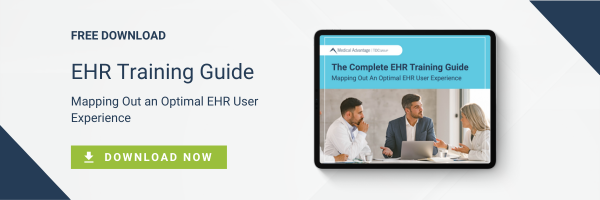If your organization is falling behind in areas such as performance, care outcomes for patients, or transparency with patients, then it is time to assess your electronic health records (EHR) system as a root cause. While frustrations with electronic medical records that lead to burnout are common among medical professionals, options are available to improve a current EHR rather than replace it with a new one. During EHR implementation and ongoing maintenance, you often can unlock EHR potential that can prevent or alleviate those frustrations.
EHR Maintenance Cost
Basic EHR maintenance costs include hardware and software license maintenance agreements, cloud- based EHR maintenance (i.e., automated updates), ongoing staff education, telecom fees, and IT support fees. Your organization also may need to hire new staff, such as IT operations staff, clinical data analysts, or application analysts. However, while ongoing EHR system maintenance is important, the following areas for optimization should be assessed regularly to ensure you are getting the best ROI on your EHR investment.
Maintaining EHR Interoperability
Maintaining EHR interoperability is important because it helps providers and patients by providing access to critical healthcare data, reducing errors, increasing efficiency, and improving patient care. A health system also will benefit from increased efficiency that allows them more time for seeing more patients and delivering quality care.
To assess interoperability, ask the following questions about your health information technology:
- Does it eliminate barriers between patients and their health records?
- Does it use standardized code systems and data sets?
- Does it keep information secure and protected?
- Does it have integrated workflows that promote efficient transfers of data?
If the answer to one or more questions is “no,” then you definitely have room for EHR improvement. For practices lacking the time or resources to address these issues, an experienced EHR consultant can guide you on your journey to sufficient interoperability.
Supporting and Maintaining Patient Engagement
Patient engagement is mutually beneficial for both providers and patients. Benefits include improved health outcomes, increased satisfaction with the patient experience, cost reduction, and a stronger provider-patient relationship.
However, poor patient engagement impacts quality scoring from Centers for Medicare & Medicaid Services (CMS). To avoid penalties, reap incentives, and reduce administrative burden and stress, patient involvement should be encouraged and supported. In addition, the 21st Century Cures Act Final Rule calls for seamless and secure access, exchange, and use of electronic health information.
Your EHR can successfully support compliance – and promote patient engagement. It also can provide a feedback loop through automated patient satisfaction survey requests, that gives providers an opportunity to learn from patient experiences. To foster engagement, encourage patients to use patient portal features such as:
- Online scheduling, billing statements and payment options
- Remote communication such as video chats and secure direct messages
- Educational information, clinical results, and visit notes
- Electronic check-in and registration
- Proxy access to the patient chart for adolescents, parents, and caregivers
To ensure your patient portal is user-friendly, consider shadowing staff who have patient-facing roles and observe clinic operations from the perspective of the patient. See how your staff uses your EHR during patient interactions and ask staff about feedback they hear from patients and ideas they may have for improvements.
Data and Reporting Accuracy
Accurate reporting is essential for healthcare providers to receive credit for their hard work and take advantage of incentive programs. Tracking key performance indicators (KPIs) such as procedures, tests performed, population health statistics and gaps-in-care help to accurately reflect performance.
Best practices for decision support and healthcare reporting also include:
- Assessing key performance indicators (KPIs) — When choosing which healthcare KPIs to track, consider the goals of your organization. For example, if your goal is to improve value-based care, then your KPIs will include procedures and tests performed, population health statistics, and other data concerning gaps in care.
- Closing gaps in care — Healthcare reporting is one of the best ways to close gaps in care by tracking which patients have or have not received certain treatments or consultation. This improves both reimbursement from payers and patient outcomes.
- Benchmarking your performance — By comparing the performance of your practice against reliable benchmarks, you can determine opportunities for improvement. You have many options for benchmarking, including benchmarks relevant to local and national groups of healthcare organizations, practice groups, ACOs (Accountable Care Organizations) and more.
- Integrating data across systems—Use dashboards to automatically, securely, and efficiently source data from operational databases such as your EHR, patient intake software, accounting software, etc. Then consolidate that data into one central report from which you can parse data and drill down to discover new insights.
Maximizing Reimbursements
Your EHR can both increase and help to recover revenue streams, but only if it is optimized. If your EHR is not operating properly, you may be losing money from claim denials, mismanaged patient billing, and missing shared savings with the Merit-based Incentive Payment System (MIPS) or other incentive programs.
Examples of how your EHR can improve reimbursements include:
- Denied claims or other unresolved billing issues can be set to automatically transmit to the responsible party
- Trends can be tracked in claim denial management and billing workflows to find adjustment opportunities that prevent errors and support best practices
- Features that are designed for both first pass and clean claims ratios respectively can configure your EHR to stay on top of the requirements of your payer mix
- Claim denials can be prevented by setting up alerts for staff to verify insurance, confirm authorization, update insurance, capture images of insurance cards, or update patient information
Assessing User Satisfaction and Ongoing Training
EHR maintenance starts with communicating with your staff. Ask for input that will help you pinpoint any problems and opportunities for improvement. If your staff is using workarounds, find out why and look for optimization or training opportunities to fix the issues creating the workarounds. Or, if they found workarounds that increase efficiency, then consider incorporating these into training materials that will replace current guidelines.
Next, look at your current training materials. When was the last time your organization’s EHR job aides, workflow manuals, and instructions were updated? To ensure the standards you put in place are being followed, observe staff members and see if they are adhering to the same guidelines that are used to train new staff. If they are not, ask them why. It may be because those instructions are outdated or are no longer applicable to their role. Or your staff may need a refresher.
When in doubt, you can reach out to an EHR training consultant who can assist with everything from updating work instructions to remote or on-site staff training.
Summary: A Holistic Approach to EHR Maintenance
Aside from routine technical EHR maintenance, you also must continuously seek opportunities for improvement to ensure that you are getting the most value out of your EHR. Be critical in your assessments in areas such as reporting and patient engagement to maximize your EHR’s potential. Collect feedback from all stakeholders, staff included, to pinpoint and address specific problems.

Medical Advantage Can Help
Regular EHR maintenance can produce improvements that will reduce hours spent on paperwork and provide a first-rate experience for patients. For over 20 years, healthcare organizations have partnered with our consultants for everything from EHR implementation to maintenance and EHR optimization – and have seen an improvement in care quality across the board as a result. To explore how to get the most from your EHR, reach out to us today.






